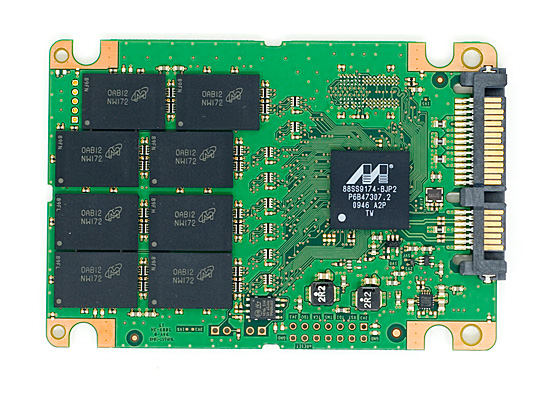6Gbps SATA Performance: AMD 890GX vs. Intel X58/P55
by Anand Lal Shimpi on March 25, 2010 12:00 AM EST- Posted in
- Storage
Final Words
AMD’s ATI acquisition was about bringing graphics to the portfolio with the eventual goal of integration into the CPU itself. We’ll see the first of that early next year with Llano. But as AMD goes down this integration route, it needs to make sure that its chipsets are at least up to par with Intel’s. Many have complained about AMD’s South Bridges in the past, but with SB850 we’ve actually seen some real improvement. There still appear to be some strange behaviors and I don’t like that there’s any discrepancy between AMD’s reference board and retail 890GX boards, but these results look very promising.
AMD’s native 6Gbps implementation manages to outperform both Marvell and Intel’s controllers in the 4KB random write test by a substantial margin. AMD’s sequential read speed is lower than the Marvell controller, and random read speed is lower than Intel’s 3Gbps controller. With a bit of work, AMD looks like it could have the best performing SATA controller on the market.
Intel’s X58 still has a few tricks left up its sleeve - it manages to be a very high performing 3Gbps SATA controller. Other than in sequential read speed, it’s even faster than Marvell’s 6Gbps controller with a 6Gbps SSD - although not by much.

Marvell makes the only 6Gbps SSD controller today. By next year that will change.
The P55 and H55 platforms are far less exciting. Any 6Gbps controller connected off the PCH is severely limited by Intel’s use of PCIe 1.0 slots. Unfortunately this means that you’ll have to use the 16 PCIe 2.0 lanes branching off the CPU for any real performance. That either results in you limiting your GPU to only 8 lanes or dropping back down to PCIe 1.0 if you have two graphics cards installed. ASUS’ PLX solution is an elegant workaround for the specific case of a user having two graphics cards and a 6Gbps SATA controller on-board. Our tests show that it does work well.
We have to give AMD credit here. Its platform group has clearly done the right thing. By switching to PCIe 2.0 completely and enabling 6Gbps SATA today, its platforms won’t be a bottleneck for any early adopters of fast SSDs. For Intel these issues don't go away until 2011 with the 6-series chipsets (Cougar Point) which will at least enable 6Gbps SATA.










57 Comments
View All Comments
assassin37 - Thursday, March 25, 2010 - link
why isnt the x-58 gigabyte native 6gbs board on the write benchmarks?blacksun1234 - Thursday, March 25, 2010 - link
I would like to see HD Tune & HD Tach Average Read speed with Crucial HDD for each chipset. With this benchmark, AMD SB850 can beat Marvell's solution a lot!Nickel020 - Thursday, March 25, 2010 - link
There's a small error on page 4, that's an X58A-UD3R you've got there, not an X58-UD3R.Also, there seem to be two different Marvell 6G controllers, the 88SE9123 and the 88SE9128, what's difference between these two?
Nickel020 - Thursday, March 25, 2010 - link
Finished reading, very interesteing results :)I find it really strange that P55 performs so poorly, I wonder whether it also performs poorly when used with SATA 3G SSDs, seeing as I'm just about two migrate my Vertex 60GB RAID 0 from P45&ICH10R to P55.
Would be great if you could look into that as well, better storage performance would be a major reason to buy S1366 instead of S1156.
Etern205 - Thursday, March 25, 2010 - link
If it's possible, mind adding the Asus U3S6 to your test (in a updated article) since that card uses a PCIe x4 interface.Thank You! :)
The card
http://www.newegg.com/Product/Product.aspx?Item=N8...">http://www.newegg.com/Product/Product.a...&cm_...
nerdtalker - Thursday, March 25, 2010 - link
That's an interesting card, since it appears from the photo to incorporate the 4x PCIe 1.0 PLX controller, or essentially the same on-motherboard solution ASUS was using.That seems like a much more interesting card to test.
7Enigma - Thursday, March 25, 2010 - link
Hi Anand,I have to admit that this particular article was a bit confusing for me. Probably because the test rigs are so similar in name I was going back and forth. My question is how does this article's results correlate to earlier boards (P45 for me in particular)? Am I understanding things correctly to assume that sticking a 6Gbps SATA card would actually be detrimental to performance in my rig if I was to get a new SSD in the coming months?
Thanks for the informative article.
semo - Thursday, March 25, 2010 - link
Hi Anand,On the 1st page, were you comparing Vertex LE performance on 890GX vs X58 or H55? And also do you have any comments on why it's random read is slower than the random write. AFAIK this is the only SSD with such characteristics.
Thanks
Casper42 - Thursday, March 25, 2010 - link
I noticed the same. Text says compared to X58 but both charts on page 1 say H55.Exodite - Thursday, March 25, 2010 - link
With the Thuban hexa-cores and 890X/FX boards in the pipeline AMD looks better and better for my next rig. After building a 790FX/PII 965BE rig for a friend, however, I were worried by the obviously poor disk performance even in comparison to my old P35/E6600 setup with an older HDD.I appreciate being kept up to date with this development as I see disk performance as the only major drawback of the platform at this point.